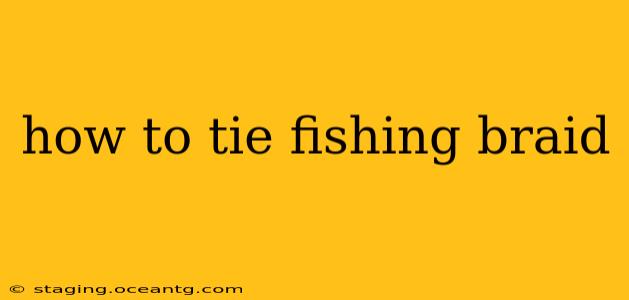Fishing braid, with its incredible strength and sensitivity, has revolutionized angling. However, its slickness presents a unique challenge: tying reliable knots. This guide covers several popular and effective knots for tying fishing braid, catering to both beginners and experienced anglers. We'll also address common questions and concerns.
Why Choosing the Right Knot for Fishing Braid Matters
The right knot is crucial for preventing line breakage and lost fish. Braid's smooth surface requires knots that grip well and resist slippage under pressure. A poorly tied knot can lead to lost tackle, frustration, and even dangerous situations. Choosing the right knot also depends on what you're fishing with. Are you using a leader? What type of lure or bait? Let's dive in!
What are the best knots for tying fishing braid to a leader?
Several knots excel at joining braid to a leader, a crucial connection for many fishing setups. The most popular include:
-
FG Knot: The FG Knot (Fuji Grip Knot) is renowned for its strength and small profile, ideal for sensitive techniques. It’s a bit more complex to learn than some others, but the payoff in strength and smoothness is substantial. Many consider it the strongest knot for joining braid to fluorocarbon.
-
Albright Knot: The Albright Knot is a classic and relatively easy-to-learn knot perfect for connecting different diameter lines. It's reliable and strong, though might be slightly bulkier than the FG knot.
-
Improved Clinch Knot with a Palomar: For connecting to a monofilament or fluorocarbon leader, using an Improved Clinch knot then adding a Palomar Knot will add extra security, making this option suitable for heavier line.
What are the best knots for tying fishing braid to lures?
For directly connecting braid to lures, these knots provide excellent performance:
-
Improved Clinch Knot: A simple and reliable knot, the Improved Clinch Knot is a go-to for many anglers, offering a good balance of strength and ease of tying. It's essential to ensure a tight, well-seated knot.
-
Uni Knot: The Uni Knot is another strong and popular choice for connecting to lures and hooks. It's relatively easy to tie and creates a compact knot that minimizes bulk.
-
Palomar Knot: The Palomar Knot is known for its strength and ease of tying. It creates a loop that's excellent for swivels and lures with a loop connection. It's a great all-around choice.
How to Tie Specific Knots (Step-by-Step Instructions)
We'll provide detailed, step-by-step instructions with images for each knot mentioned above in a future, more in-depth article. This article is focusing on the key considerations and types of knots.
Troubleshooting Common Braid Knot Problems
-
Knots slipping: This is usually due to insufficient tightening or improper knot construction. Ensure you wet the line while tightening and take your time for a secure knot.
-
Knots breaking: This could indicate a weak point in the line, a poorly tied knot, or too much pressure on a thin knot.
Maintaining Your Braid
Regular maintenance is crucial for maximizing the lifespan and strength of your fishing braid. Avoid dragging it across abrasive surfaces, and store it properly to prevent damage. Inspect your braid before each fishing trip and replace it when necessary.
Conclusion
Mastering braid knots is essential for successful fishing. By understanding the strengths and weaknesses of different knots and following proper tying techniques, you can significantly improve your fishing experience. Remember to practice regularly to build proficiency and confidence in your knot-tying skills. Regular practice is key! Soon, you'll be tying reliable knots quickly and efficiently, focusing more on the fishing and less on the knots.
